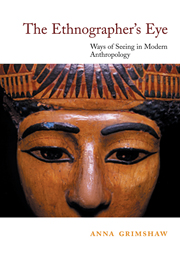Book contents
- Frontmatter
- Contents
- Preface
- Acknowledgements
- Introduction
- Part I Visualizing anthropology
- 1 The modernist moment and after, 1895–1945
- 2 Anxious visions: Rivers, Cubism and anthropological modernism
- 3 The innocent eye: Flaherty, Malinowski and the romantic quest
- 4 The light of reason: John Grierson, Radcliffe-Brown and the enlightenment project
- Part II Anthropological visions
- Epilogue
- Notes
- Index
1 - The modernist moment and after, 1895–1945
Published online by Cambridge University Press: 05 June 2012
- Frontmatter
- Contents
- Preface
- Acknowledgements
- Introduction
- Part I Visualizing anthropology
- 1 The modernist moment and after, 1895–1945
- 2 Anxious visions: Rivers, Cubism and anthropological modernism
- 3 The innocent eye: Flaherty, Malinowski and the romantic quest
- 4 The light of reason: John Grierson, Radcliffe-Brown and the enlightenment project
- Part II Anthropological visions
- Epilogue
- Notes
- Index
Summary
Introduction
In December 1895 Auguste and Louis Lumière presented their newly patented cinematographe to a public audience for the first time. They showed ten short films, each of which lasted barely a minute. But with this programme, cinema was born. The first London screening took place in February 1896; and by the end of that year the Lumière films had been seen in New York and widely across Europe and Asia. Public interest was stimulated as much by the instrument itself as by what it could do, that is record actuality, the world in movement. John Grierson commented in 1937:
When Lumière turned his first historic strip of film, he did so with the fine careless rapture which attends the amateur effort today. The new moving camera was still, for him, a camera and an instrument to focus on the life about him. He shot his own workmen filing out of the factory and this first film was a ‘documentary’. He went on as naturally to shoot the Lumière family, child complete. The cinema, it seemed for a moment, was about to fulfill its natural destiny of discovering mankind.
Some three years after the first Lumière screening, Alfred Cort Haddon organised a fieldwork expedition to the Torres Straits islands from Cambridge. He gathered together a group of six scientists and they set out to study the native peoples of a small group of islands lying to the north of Australia.
- Type
- Chapter
- Information
- The Ethnographer's EyeWays of Seeing in Anthropology, pp. 15 - 31Publisher: Cambridge University PressPrint publication year: 2001

